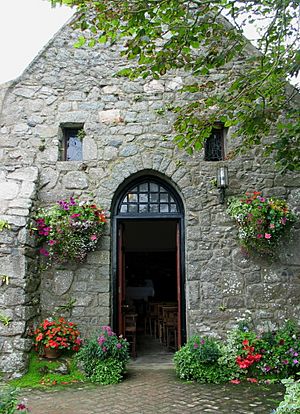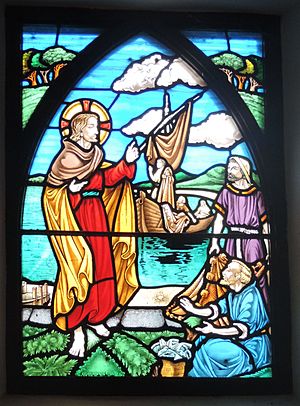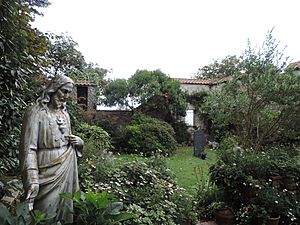St Tugual's Chapel facts for kids
Quick facts for kids St Tugual's Chapel |
|
|---|---|

The entrance to St Tugual's Chapel
|
|
| Region | None |
| Location | |
| State | States of Guernsey |
St Tugual's Chapel is a very old building on the island of Herm. It's a special kind of small church, or chapel, that isn't tied to one specific religion. It's open for everyone. This chapel was built way back in the 11th century, which means it's over 900 years old! Herm is the smallest of the Channel Islands that people can visit. Today, St Tugual's Chapel is officially recognized as an important old building by the government of States of Guernsey. It's on their list of ancient monuments, which helps protect it.
Contents
The History of St Tugual's Chapel
This chapel, as we see it today, was built in the 11th century. However, some people think that this spot has been a special religious place since the 6th century. It's not completely clear if the chapel was named after Saint Tugual because he visited Herm, or if his followers named it after him.
The chapel you can visit now was built by Norman monks. These monks lived on the island of Herm a very long time ago.
In 1949, the Wood family took over the lease of Herm island. They worked to reopen parts of the chapel. They also cleaned up several of its windows, letting more light in.
St Tugual's Chapel was even featured on a stamp in 1970. This shows how important it is to the island's history.
Chapel Restoration Work
In 2010 and 2011, St Tugual's Chapel was closed for important restoration work. This means it was carefully repaired and made stronger. During this time, the roof was replaced, and the walls were re-pointed and re-rendered. New drainage systems were also put in place to protect the building from water.
The States of Guernsey government is responsible for keeping the chapel in good condition. After all the work was finished, the chapel reopened in May 2011. There was a special service to celebrate its reopening.
Skeletons Found at the Chapel
During the restoration work in 2010 and 2011, something very interesting was discovered. Workers found two skeletons! One was an adult and the other was a child. At first, experts thought these skeletons were about 400 to 500 years old.
Soon, more skeletons were expected to be found. Eventually, in an area of about 15 square meters, a total of 40 skeletons were uncovered. About half of these were children's skeletons. A team led by Philip de Jersey took the skeletons to Guernsey for study. After they were studied, the skeletons were respectfully returned to Herm for burial. The oldest bones found dated back to the second half of the 10th century.
See also
 In Spanish: Capilla de San Tugdual para niños
In Spanish: Capilla de San Tugdual para niños



